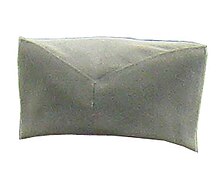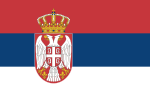Šajkača
 Šajkača, worn by or as:
| |
| Type | Cap |
|---|---|
| Place of origin | Serbia |
| Introduced | 18th-century |
The šajkača (Serbian Cyrillic: шајкача, pronounced [ʃǎjkatʃa]) is the Serbian national hat or cap. Traditionally worn by men in the Serbian countryside, it is named after Serb river troops known as šajkaši. A popular national symbol in Serbia since the beginning of the 20th century, it is typically black, grey or green in colour and is usually made of soft, homemade cloth. It became widely worn by Serb men beginning in the 1880s and was a key component in the uniform of the Serbian military from the end of the 19th century.[1] Today, it is mostly worn by elderly men in rural communities.
History


The šajkača is believed to have originated in the Serbian region of Banat during the 18th century, when šajkaši (Serb river troops in the service of the Austrian Empire) guarded the Danube and Sava rivers against the Ottoman Empire and wore caps in the shape of an overturned chaika (Serbian: шајка) boat.[citation needed]
Through most of the 19th century, the fez was the dominant choice of headwear for both Muslims and Christians in the Balkans, and fezzes were frequently emblazoned with national or religious symbols. In Serbia, for example, regulations for ministerial uniforms from 1850 required the Serbian coat of arms be featured on officials' red fezzes.[2] It was not until the decade following the Serbian-Ottoman Wars of 1876–1878 that the šajkača began to overtake the fez in popularity among Serbs and thus very few paintings or photographs exist featuring the šajkača in use prior to the early 20th century.[3][1]
The typical cap of peasants from the Šumadija region of Serbia,[4] the šajkača eventually acquired a dual purpose: it was worn by civilians in the countryside, and it became part of the standard Serbian military uniform other than in full dress.[5][6] During World War I, the cap was regularly worn by the soldiers of the Kingdom of Serbia.[7] Serbia was eventually overrun by a combined Austro-Hungarian, German and Bulgarian invasion in 1915, and in 1916 the wearing of the šajkača, alongside other Serbian folk attire, was outlawed by Bulgarian authorities in the wake of the Bulgarian occupation of southern Serbia.[8]
During World War II, the šajkača was the standard hat worn by Serbian Chetnik irregulars in the Axis-occupied Kingdom of Yugoslavia.[9] It was also worn by Serbian Partisans. After the war, it was replaced by the Titovka cap in the armed forces of communist Yugoslavia.[10]
The šajkača was worn by Serb soldiers during the breakup of Yugoslavia. Bosnian Serb reservists and paramilitaries wore the cap during the 1992–95 Bosnian War, and it was later adopted by Bosnian Serb forces to be the official headgear of the Army of Republika Srpska (Serbian: Vojska Republike Srpske, VRS).[11] Following the 1991 Battle of Vukovar, fought during the Croatian War of Independence, Croatian Serb authorities erected gravestones to the Serb soldiers who were killed fighting for the city. These were originally topped with sculptural evocations of the šajkača cap. After Vukovar's reintegration into Croatia the gravestones were repeatedly vandalized, leading the Serb community in the town to replace them with more neutral gravestones without any overt military connotations.[12] The 1999 NATO bombing of Yugoslavia saw McDonald's chains in Serbia promote their products by distributing posters and lapels which depicted the šajkača standing atop the golden arches of the McDonald's logo in an attempt to bolster Serbian national pride.[13]
The šajkača has been a popular national symbol in Serbia since the beginning of the 20th century.[14] It is commonly worn by elderly men in the Serbian countryside,[14] whereas Serbian youth wear traditional costumes only for folklore concerts.[15]
Design
Designed with a V-shaped top in the form of an overturned chaika,[16] the šajkača is narrow and typically black or grey in colour.[17] It is usually made of soft, homemade cloth[18] and is worn without any symbols during peacetime. During times of war, cockades featuring the Serbian double-headed eagle[19] and the motto Only Unity Saves the Serbs are often seen on the cap.[14] The šajkača worn by Serbian soldiers during World War I had a non-reflecting peak and was topped with a royal monogram.[20]
- Youths in traditional costumes of Šumadija
- Boys wearing the šajkača
See also
Notes
- ^ a b Јасна Бјеладиновић (1 September 2011). Народне ношње Срба у XIX и XX веку. [Књ. 2]: Serbian Ethnic Dress in Nineteenth and Twentieth Centuries. [Book 2]. Etnografski muzej u Beogradu. p. 49. ISBN 978-86-7891-059-3.
- ^ A. Maxwell (5 August 2014). Patriots Against Fashion: Clothing and Nationalism in Europe’s Age of Revolutions. Springer. ISBN 978-1-137-27714-5.
- ^ Никола Пантелић. Гласник Етнографског музеја у Београду, књ. 48. Etnografski muzej u Beogradu. p. 192. GGKEY:9N17LX3FNL2.
- ^ Resić & Plewa 2002, p. 48.
- ^ Knotel, Richard. Uniforms of the World. A Compendium of Army, Navy and Air Force Uniforms 1700-1937. pp. 314–315. ISBN 0-684-16304-7.
- ^ Jovanović 2000, p. 268.
- ^ Jordan 2008, p. 20.
- ^ Mitrović 2007, p. 224.
- ^ Denitch 1996, p. 74.
- ^ Serbian Mirror.
- ^ Taylor 2008, p. 143.
- ^ Kardov 2007, pp. 71–73.
- ^ Ungson & Wong 2008, p. 211.
- ^ a b c Deliso 2009, p. 97.
- ^ Zamurović, Slani & Phillips-Tomašević 2002, p. 194.
- ^ Vesti Online & 30 April 2010.
- ^ Mitchell 2010, p. 41.
- ^ Upoznaj Srbiju & 17 May 2011.
- ^ Thomas & Mikulan 2006, p. 59.
- ^ Thomas 2001, p. 38.
References
- Books
- Bjeladinović, Jasna (2011). Serbian Ethnic Dress in the Nineteenth and Twentieth Centuries. Belgrade: Belgrade Ethnographic Museum. ISBN 978-86-7891-059-3.
- Deliso, Christopher (2009). Culture and Customs of Serbia and Montenegro. Westport, Connecticut: Greenwood Publishing Group. ISBN 978-0-313-34436-7.
- Denitch, Bogdan Denis (1996). Ethnic Nationalism: The Tragic Death of Yugoslavia. Minneapolis, Minnesota: University of Minnesota Press. ISBN 978-0-8166-2947-3.
- Đorđević, Mirko (2000). "Populist Wave Literature". In Popov, Nebojša; Gojković, Drinka (eds.). The Road to War in Serbia: Trauma and Catharsis. Budapest: Central European University Press. ISBN 978-963-9116-56-6.
- Jordan, David (2008). The Balkans, Italy & Africa 1914–1918: From Sarajevo to the Piave and Lake Tanganyika. London: Amber Books Ltd. ISBN 978-1-906626-14-3.
- Jovanović, Goran (2000). "The Yugoslav War Through Cartoons". In Halpern, Joel Martin; Kideckel, David A. (eds.). Neighbors at War: Anthropological Perspectives on Yugoslav Ethnicity, Culture, and History. University Park, Pennsylvania: Penn State University Press. ISBN 978-0-271-04435-4.
- Kardov, Kruno (2007). "Remember Vukovar". In Ramet, Sabrina P; Matić, Davorka (eds.). Democratic Transition in Croatia: Value Transformation, Education, and Media. College Station, Texas: Texas A&M University Press. ISBN 978-1-58544-587-5.
- Mitchell, Laurence (2010). Serbia. Buckinghamshire, England: Bradt. ISBN 978-1-84162-326-9.
- Mitrović, Andrej (2007). Serbia's Great War, 1914–1918. London: Purdue University Press. ISBN 978-1-55753-477-4.
- Resić, Sanimir; Plewa, Barbara Törnquist (2002). The Balkans in Focus: Cultural Boundaries in Europe. Lund, Sweden: Nordic Academic Press. ISBN 978-91-89116-38-2.
- Taylor, Tony (2008). Denial: History Betrayed. Melbourne: Melbourne University Press. ISBN 978-0-522-85907-2.
- Thomas, Nigel (2001). Armies in the Balkans: 1914–18. Oxford: Osprey Publishing. ISBN 978-1-78096-735-6.[permanent dead link]
- Thomas, Nigel; Mikulan, Krunoslav (2006). The Yugoslav Wars: Slovenia & Croatia 1991–95. Oxford: Osprey Publishing. ISBN 978-1-4728-0196-8.
- Ungson, Gerardo R.; Wong, Yim-Yu (2008). Global Strategic Management. Armonk, New York: M.E. Sharpe. ISBN 978-0-7656-2897-8.
- Zamurović, Dragoljub; Slani, Ilja; Phillips-Tomašević, Madge (2002). Serbia: Life and Customs. Belgrade: Applied Artists and Designers Association of Serbia. ISBN 978-86-82893-09-7.
- Journals
- Websites
- "Šajkača nas je održala". Serbian Mirror.
- "Šajkača – poreklo i značaj srpske kape". Upoznaj Srbiju. 17 May 2011.
- "Šajkaču izmislili u Banatu". Vesti Online. 30 April 2010.



